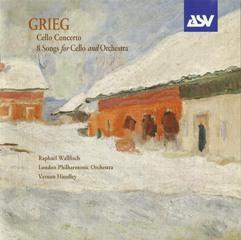Grieg – Cello Concerto, Songs for Cello and Orchestra (2004)
Grieg – Cello Concerto, Songs for Cello and Orchestra (2004)

01. Cello Concerto (after cello sonata) - I. Allegro agitato [0:10:24.52] 02. Cello Concerto (after cello sonata) - II. Andante molto tranquillo [0:06:37.23] 03. Cello Concerto (after cello sonata) - III. Introduzione - allegro [0:12:54.30] 04. "Last Spring" from 2 Elegiac Melodies, op.34 no.2 [0:04:34.65] 05. "The wounded heart" from 2 Elegiac Melodies op.34 no.1 [0:03:13.00] 06. "Solveig's song" from Peer Gynt op.55 no.4 [0:04:43.42] 07. "Ingrid's lament" from Peer Gynt op.55 no.1 [0:05:06.73] 08. "The first meeting" from 2 Melodies op.53 no.1 [0:04:04.52] 09. "Norwegian" from 2 Melodiess op.53 no.2 [0:04:06.15] 10. "Jeg elsker dig" from Melodies of the Heart op.5 no.3 [0:02:47.13] 11. "To spring" from Lyric Pieces, Book 3, op.43 no.6 [0:03:21.32] Raphael Wallfisch - cello London Philharmonic Orchestra Vernon Handley – conductor
Do we need another ’cello concerto? Is it chance, or something in the piece itself, as to how well chamber music works in orchestration? Schoenberg’s arrangement of the first of Brahms’s Piano Quartets has a firm place in the repertoire, for example; could many such transformations take place? If you are ever curious about such questions, listen to this disc, which I am very enthusiastic about.
I openly confess that I did not expect to enjoy it and was thus pleasantly surprised. Its content is enterprising – Grieg’s Cello Sonata was originally orchestrated by Joseph Horovitz in 1985, for Gary Karr, and, therefore, as a double bass concerto. This version is further adapted by Benjamin Wallfisch, the composer-son of the distinguished ’cellist, who reinstates traditional cuts.
So, does it work? Yes. Grieg’s Sonata emerges as both rhapsodic and lyrical; the orchestral sound softens the texture; the idiomatic orchestration makes one think not only of Peer Gynt, but also of Elgar; there are entertaining and imaginative brass and percussion effects. In his piano chamber writing, certainly in this sonata, Grieg makes extensive use of repeated chords, which relays a certain foursquareness and severe character. In this orchestration, these are smoothed out, giving the solo instrument, ironically, a more grateful backdrop against which to sing. If I did not know the original sonata, I would not have realised this was an arrangement, although the work becomes much less traditional, much more “romantic” in this concerto version.
As expected, Raphael Wallfisch gives a fine performance, his tone always singing, whether of violin-like delicacy or rich and passionate in big climaxes. The first movement receives a sunny, emotional performance that never loses sight of the strict sonata-form structure, but gains real expressive freedom. Handley and the LPO are sensitive accompanists; the slow movement is a particularly good example – witness the wind playing at the beginning and end and the interweaving of texture with the solo instrument throughout. Listen too to the bite and attack at the start of the first movement’s development, or the duetting between orchestra and soloist at the reprise of the last movement theme. The performance seems to lose its way towards the end of the slow movement; however, the extended finale is continuously interesting and never seems too long.
As for the song arrangements, they certainly make pleasant listening and a further opportunity to enjoy Wallfisch’s sound. Solveig’s Song is especially successful; the contrast between the slow outer and livelier middle sections well brought off. The orchestra is appropriately fiery in The Wounded Heart, but some of the slower songs, notably Ingrid’s Lament and Ich Liebe Dich, tend to drag without the added interest of words.
The recorded sound is excellent in the concerto – full but clear, with plenty of space around the orchestra. The ’cello is recorded quite close, probably necessarily so, but the balance is well judged. In the song arrangements the orchestra recedes and the closeness of the solo instrument can become wearing. The songs are therefore better dipped into than listened to straight through. If I had a criticism of the programming, it would be that the songs are rather lightweight as a filler (that takes up more then half the disc) for a release that is so musically innovative.
It could be argued that this is exactly the sort of disc an independent label should be producing. The CD’s presentation is modern and attractive – aesthetically pleasing artwork with full notes by Benjamin Wallfisch. I wish it every success. --- Ying Chang, classicalsource.com
download (mp3 @320 kbs):








